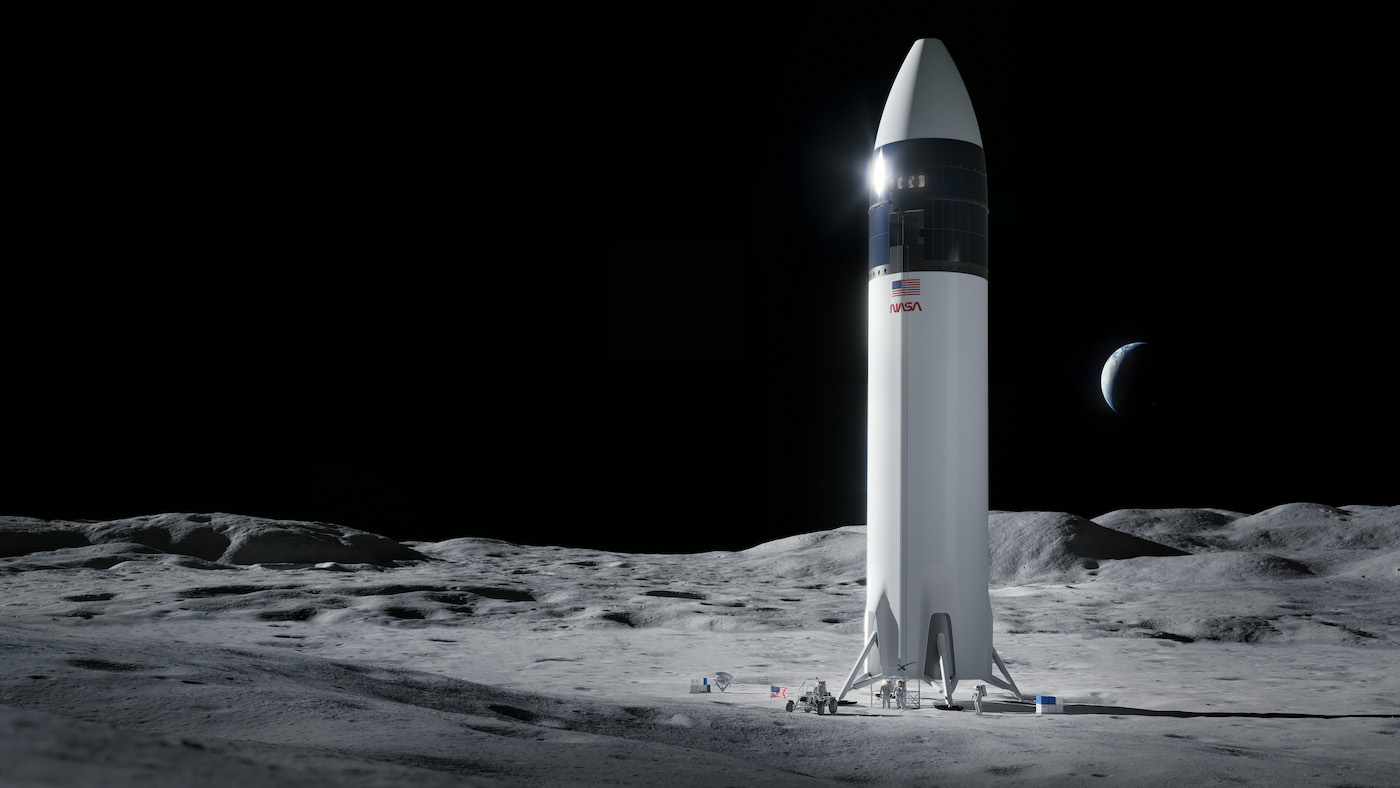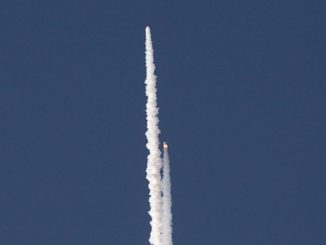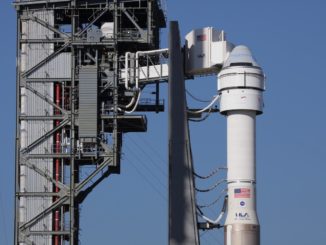
NASA has selected SpaceX to build a spacecraft to land the first astronauts on the Moon since 1972, choosing Elon Musk’s space company over competing proposals from Jeff Bezos’s Blue Origin and the aerospace firm Dynetics, officials announced Friday.
A derivative of SpaceX’s next-generation Starship vehicle will carry the astronauts to the lunar surface and launch the crew members back off the Moon. Under NASA’s plans, the astronauts will blast off from Earth on the agency’s heavy-lift Space Launch System rocket and fly an Orion capsule to the vicinity of the Moon, then transfer into the Starship for the final leg of the journey to the surface.
The human-rated lunar lander, which NASA calls the Human Landing System, is one of the final major elements of the agency’s Artemis program to be developed. NASA selected three industrial teams last year to work on lunar lander concepts, culminating in the agency’s selection of SpaceX to build the lander for the first Artemis Moon landing mission.
“Today, I’m very excited, and we are all very excited, to announce that we have awarded SpaceX to continue the development of our integrated Human Landing System,” said Lisa Watson-Morgan, NASA’s HLS program manager at the Marshall Space Flight Center. “SpaceX’s Starship is a fully reusable launch and landing system designed for travel to the Moon and other future destinations.
“It’s a single stage crewed landing system,” Watson-Morgan said. “It utilizes Earth orbit refueling of liquid oxygen and liquid methane propellants. The system leans on the company’s flight heritage of Dragon and Falcon vehicles. Starship includes a spacious cabin and two airlocks with a great deal of space for our crew, as well as additional payload capability that will permit us to take experiments to the moon, and return samples back, and do all the important science that we want to do on this mission.”
“We are humbled to help NASA usher in a new era of human space exploration,” SpaceX said in a statement.
NASA is seeking to land the first astronauts on the Moon since the final Apollo lunar mission in 1972.
“As the first human lunar lander in 50 years, this innovative Human Landing System will be a hallmark in human space exploration history,” Watson-Morgan said. “And we’re going to help write that history.”
SpaceX beat out a bid from a team led by Blue Origin, who proposed a multi-element spacecraft consisting of stages made by Lockheed Martin, Northrop Grumman, and Blue Origin itself. Draper assisted on the lander’s guidance and avionics systems.
NASA also worked with Dynetics, an aerospace and defense contractor based in Alabama, on a third human-rated lander concept.
In the end, NASA selected SpaceX’s Starship for the job of landing the next astronauts on the Moon. The firm-fixed price contract has a total value of $2.89 billion, and covers development of a test flight that will land on the Moon without astronauts on-board, then a demonstration — known as “Option A” in NASA’s procurement language — to carry a crew to the Moon’s south pole.
NASA originally planned to pick multiple companies to continue developing lunar landers, but budget restrictions forced the agency to rethink its strategy. Congress approved $850 million for the Human Landing System program in fiscal year 2021, about a quarter of what NASA requested.
That limited what NASA could do with the first HLS development contract, but officials said the agency’s “Option A” contract with SpaceX fits within the expected budget. SpaceX’s proposal had the lowest price of all three bids, but NASA and SpaceX still had to rework some of the contracts milestone payments to get the price within the agency’s funding plan.
With the final agreement complete, NASA said SpaceX will self-fund and assume financial risk for over half of the Starship landing system’s development and testing.

The Starship is significantly larger than the other human-rated lander concepts NASA evaluated, and can deliver heavier cargo to the Moon. SpaceX’s lander will stand about seven-and-half times taller than the Apollo lunar module that carried astronauts to the lunar surface.
“The scale of SpaceX’s lander architecture presents numerous benefits to NASA,” wrote Kathy Lueders, head of the space agency’s human spaceflight division, in a a source selection statement posted on NASA’s website.
Blue Origin’s proposal was the second-highest rated in NASA’s procurement process, according to the source selection document.
Steve Jurczyk, NASA’s acting administrator, said the agency considered the technical parameters, cost, and management of each of the three HLS bidders. While SpaceX won the contract to attempt the Artemis program’s human landing on the Moon, NASA will soon start another competition open for all U.S. companies to bid on a contract for a series of follow-on lunar landings later in the 2020s.
The commercial mode, where the government and industry share costs, is similar to NASA’s partnership with SpaceX that helped produce the Falcon 9 rocket and Crew Dragon spacecraft, which ferries astronauts to and from the International Space Station.
“Given the evaluation of the three proposals based on technical approach, cost, and management approach, and the budget we have available, we determined the best way forward for us was to select SpaceX for Option A, and then move forward and accelerate the landing services procurement,” Jurczyk said.
“We awarded the contract with SpaceX given the appropriations we have in FY21 and what we believe are realistic budgets in future years,” Jurczyk said. “So we believe this is doable within what we have and what we can expect in funding.”
SpaceX is building and testing Starship prototypes in South Texas. The stainless steel rocket, wider than a Boeing 747 jumbo jet — is designed for vertical takeoffs and landings, but uses a dramatic flip maneuver to switch from a horizontal “belly flop” position to an upright orientation just before touchdown.
Starship prototypes have launched on four high-altitude atmospheric test flights over the company’s rapidly-growing development facility near Brownsville, Texas. All four of the rockets have exploded during landing or shortly after touchdown.
An upgraded Starship prototype is on SpaceX’s launch pad in South Texas for another atmospheric test flight as soon as next week. The test flights are stepping stones toward an attempt to launch the Starship into low Earth orbit, which Musk says could happen later this year.
A giant booster SpaceX calls the Super Heavy will be required to hurl the massive Starship into orbit around Earth. The Super Heavy, which has not yet launched on a test flight, will be powered by 28 methane-fueled Raptor engines collectively generating more than 16 million pounds of thrust, more than twice the power of NASA’s Apollo-era Saturn 5 rocket.
Like the Starship, the Super Heavy will return to Earth for a vertical landing, and is reusable.
The spaceflight-capable Starship will have six Raptor engines. All the high-altitude Starship test flights to date have had three Raptor engines.
The Starship will serve as an upper stage, a deep space transport, a propellant transfer tug, and a planetary lander.
“Flying between lunar orbit and the surface of the Moon, Starship will carry crew and all of the supplies, equipment, and science payloads needed for extensive surface exploration,” SpaceX said. “Building off the safety and reliability of Dragon and Falcon, Starship will feature proven avionics, guidance and navigation systems, autonomous rendezvous, docking and precision landing capabilities, as well as thermal protection, and a spacious cabin with familiar displays and interfaces utilized on Dragon.”
SpaceX said it is “rapidly advancing” development of the Starship, with five test vehicles currently in production.
“Since January 2020, SpaceX has built 10 Starship prototypes, with production and fidelity accelerating on each build,” the company said. “SpaceX has manufactured and tested more than 60 of Starship’s Raptor engines, accumulating nearly 30,000 seconds of total test time over 567 engine starts, including on multiple Starship static fires and flight tests.”
In the source selection statement, Lueders said the Starship’s capabilities, in many cases, far exceed NASA’s requirements for the first Artemis landing mission. The multi-engine vehicle can recover from an engine failure, has plentiful propellant reserves, and can accommodate large and bulky payloads.
“SpaceX’s capability will support the delivery of a significant amount of additional hardware, including bulky and awkwardly- shaped equipment, for emplacement on the lunar surface,” Lueders wrote. ‘This has the potential to greatly improve scientific operations and EVA capabilities.”
Lueders also lauded SpaceX’s aggressive approach to ground and flight testing. “This will allow SpaceX to isolate and address performance and operational issues early in its development cycle,” she wrote.
But Lueders also noted the risk in SpaceX’s approach.
“SpaceX’s mission depends upon an operations approach of unprecedented pace, scale, and synchronized movement of the vehicles in its architecture,” she wrote. “This includes a significant number of vehicle launches in rapid succession, the refurbishment and reuse of those vehicles, and numerous in-space cryogenic propellant transfer events.
“I acknowledge the immense complexity and heightened risk associated with the very high number of events necessary to execute the front end of SpaceX’s mission, and this complexity largely translates into increased risk of operational schedule delays,” Lueders wrote. “However, these concerns are tempered because they entail operational risks in Earth orbit that can be overcome more easily than in lunar orbit, where an unexpected event would create a much higher risk to loss of mission.”
Under NASA’s current planning, the Starship outfitted to land astronauts on the moon will blast off on top of SpaceX’s Super Heavy booster. Once it is in orbit, a series of tankers will launch to fill the Starship with additional methane and liquid oxygen propellants, then it will fire off toward the Moon.
The Starship will maneuver into an elongated orbit around the Moon, where it can wait up to 100 days for the arrival of the astronauts on an Orion capsule after it launches on an SLS rocket from Florida. For the first Artemis landing mission, the Orion capsule will dock directly with the Starship to enable the crew to float into the lander for the trip down to the lunar surface.
After landing, the astronauts will ride an elevator from the pressurized cabin near the top of the 15-story Starship down to the ground. After performing several spacewalks, the crew will board the Starship to carry them back to the Orion spacecraft, which they will fly back to Earth.
“SpaceX will have multiple launches, and part of their concept is to have refueling in low Earth orbit,” Watson-Morgan said. “They’ll perform that refueling and that will allow them to go back and forth. Once the Starship portion is fully checked out, then the SLS will launch the Orion to the appropriate rendezvous point.”

The architecture means NASA won’t require SpaceX to prove out the Starship’s ability to re-enter the Earth’s atmosphere and perform its dramatic landing maneuvers with people on-board. That job will be done with the Orion capsule with a more traditional parachute-assisted splashdown in the sea.
But SpaceX eventually wants to use the Starship system as an all-in-one transporter to ferry people throughout the solar system. Musk’s ambition is to make the Starship easily reusable, significantly slashing the cost of space transportation.
Each copy of NASA’s Space Launch System rocket can only be used once. The first SLS test launch is scheduled for late this year or early 2022, and the all-up Artemis 1 demonstration mission will send an unpiloted Orion spacecraft to orbit the Moon, paving the way for the first SLS/Orion launch with astronauts in 2023.
Artemis schedule under review
The Trump administration planned for the third Artemis mission in 2024 to be the program’s first attempt to land astronauts on the moon.
Jurczyk said Friday that NASA and the Biden administration, which has endorsed the Artemis program, are conducting an “internal comprehensive review” of the lunar program to “ensure that they can be implemented as quickly, efficiently, and effectively as possible.”
NASA’s contract with SpaceX provides for a lunar landing as soon as 2024. “That’s what’s in the plan right now that SpaceX proposed and we’re awarding a contract for,” Jurczyk said.
“These human rated system developments are very complex, and there is risk, but the NASA team will have the insight into the progress that SpaceX is making, if they’re hitting their milestones, if they have a shot at 2024,” Jurczyk said. “We’ll keep you updated as we move along with SpaceX.”
Later in the 2020s, NASA aims to build a mini-space station called the Gateway in orbit around the Moon. Future lunar missions after the first Starship landing will come and go from the Gateway, which will act as a research lab, astronaut safe haven, and a refueling station in deep space.
“We are working diligently with the partners to ensure we meet our national goals of landing the next American astronauts on the Moon as quickly and safely as possible,” Jurczyk said. “At least one of those astronauts will make history with this lander as the first woman on the Moon … Additionally, the first person of color will also walk on the Moon as part of the Artemis program.”
Email the author.
Follow Stephen Clark on Twitter: @StephenClark1.



